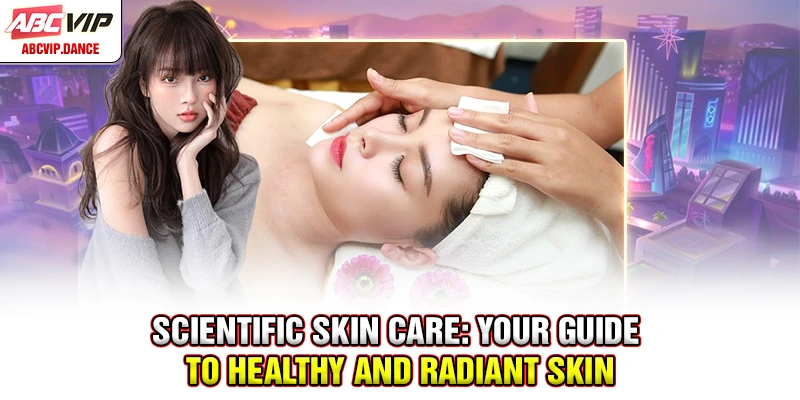Scientific skin care uses evidence-based methods and proven ingredients to achieve healthy, glowing skin. With endless beauty trends, this guide of ABCVIP simplifies the process, covering the basics of scientific skin care and helping you build an effective, personalized routine that meets your skin’s unique needs.
What is scientific skin care?
Scientific skin care refers to a methodical approach to skin health that relies on clinical research, dermatological science and proven ingredients. Unlike fad treatments or unverified remedies, this method emphasizes safety, results, and long-term benefits.
Key aspects of scientific skin care include:
- Evidence-based ingredients: Products are formulated with ingredients that have been tested and proven to work, such as retinol, niacinamide and hyaluronic acid.
- Personalized solutions: Treatments are tailored to individual skin types and concerns.
- Focus on prevention: Scientific skin care emphasizes preventing damage (e.g., using sunscreen) rather than just treating issues.
- Dermatologist-approved products: Many products are developed or endorsed by dermatologists for their safety and efficacy.
This approach ensures that your skin receives what it truly needs, eliminating guesswork and reducing the risk of irritation or damage.

The science behind skin care
To fully embrace scientific skin care, it’s important to understand how your skin works.
The skin is the body’s largest organ, composed of 3 main layers:
- Epidermis: The outermost layer that acts as a barrier, protecting against external factors like pollution and UV rays.
- Dermis: The middle layer containing collagen, elastin, and blood vessels, responsible for skin’s elasticity and resilience.
- Hypodermis: The deepest layer that stores fat and provides insulation and cushioning.
Each layer plays a crucial role in maintaining skin health, and scientific skin care focuses on nourishing all layers for optimal results.
Common skin concerns and their scientific solutions
The skin is a complex organ, and various internal and external factors can lead to common skin concerns. Below is a detailed look at some of the most common skin issues and their scientific remedies.
Acne
Acne occurs when pores become clogged with oil, dead skin cells, and bacteria, leading to inflammation, blackheads, whiteheads, or cystic lesions.
Scientific solutions:
- Salicylic Acid: A beta-hydroxy acid (BHA) that exfoliates deep within the pores to remove oil and dead skin buildup.
- Benzoyl peroxide: Kills acne-causing bacteria & reduces inflammation.
- Retinoids: Regulate cell turnover to prevent clogged pores and reduce existing acne.
- Niacinamide: Reduces redness, controls sebum production, and strengthens the skin barrier.
Pro Tip: Combine salicylic acid and niacinamide for a gentle yet effective acne treatment, but avoid overusing active ingredients to prevent irritation.

Aging skin
Signs of aging include the development of subtle creases, a reduction in firmness, and variations in skin tone. These changes are primarily caused by a decline in collagen and elastin production, as well as damage from UV rays and free radicals.
Scientific solutions:
- Retinol: Stimulates collagen production, improves skin texture and elasticity.
- Peptides: Short chains of amino acids that signal the skin to produce more collagen and repair itself.
- Vitamin C: A potent antioxidant that neutralizes free radicals, brightens skin, and promotes collagen synthesis.
- Sunscreen: Prevents further damage by protecting the skin from harmful UV radiation.
Pro Tip: Incorporate retinol into your nighttime routine and pair it with sunscreen during the day for maximum anti-aging benefits.
Hyperpigmentation
Hyperpigmentation appears as dark spots, patches, or uneven skin tone caused by excess melanin production. It can result from sun exposure, hormonal changes, or inflammation (e.g., post-acne marks).
Scientific solutions:
- Niacinamide: Reduces melanin transfer to the skin surface, lightening dark spots over time.
- Vitamin C: Fades pigmentation while protecting the skin from UV-induced damage.
- Kojic Acid: Inhibits melanin production & brightens skin.
- Hydroquinone: A dermatologist-recommended ingredient for stubborn pigmentation, available in prescription-strength formulations.
Pro Tip: Pair niacinamide with vitamin C for a safer and effective brightening routine that minimizes hyperpigmentation.
Dry and dehydrated skin
Dry skin and dehydrated skin are distinct conditions with different underlying causes. Both conditions can lead to dullness, flakiness, and a compromised skin barrier.
Scientific solutions:
- Hyaluronic Acid: A humectant that attracts & retains moisture in the skin, leaving it plump.
- Ceramides: Lipids that restore the skin’s natural barrier, preventing water loss and protecting against environmental damage.
- Glycerin: A deeply hydrating ingredient that draws water to the skin and keeps it supple.
- Squalane: A lightweight oil that mimics the skin’s natural sebum, providing long-lasting hydration without clogging pores.
Pro Tip: Layer a hyaluronic acid serum under a ceramide-rich moisturizer for optimal hydration and barrier repair.
Oily skin and enlarged pores
Oily skin is characterized by excess sebum production, which can lead to shiny skin & enlarged pores.
Scientific solutions:
- Salicylic Acid: Penetrates deep into the pores to dissolve oil and prevent blockages.
- Niacinamide: Regulates sebum production & minimizes the appearance of pores.
- Clay Masks: Absorb excess oil & detoxify the skin.
- Retinol: Improves skin texture and reduces pore size over time by increasing cell turnover.
Pro Tip: Use clay masks once or twice a week and follow up with niacinamide to balance oil production.
Sensitive skin
Sensitive skin is prone to redness, irritation, and inflammation, often reacting to harsh ingredients or environmental triggers.
Scientific solutions:
- Aloe Vera: Soothes skin.
- Centella Asiatica (Cica): Reduces redness and promotes healing.
- Colloidal Oatmeal: Provides relief for itchy or inflamed skin while reinforcing the skin barrier.
- Ceramides: Strengthen the skin’s barrier to protect against irritants.
Pro Tip: Look for fragrance-free, hypoallergenic products with calming ingredients to avoid triggering sensitivity.
Sun damage
Sun damage manifests as dark spots, fine lines, and an increased risk of skin cancer due to prolonged UV exposure.
Scientific solutions:
- Sunscreen: The most effective prevention tool, with SPF 30 or higher and broad-spectrum protection.
- Vitamin C: Repairs UV-induced damage and brightens the skin.
- Retinol: Reverses sun damage by boosting collagen production and improving skin texture.
- Antioxidants: Ingredients like green tea extract and resveratrol neutralize free radicals caused by sun exposure.
Pro Tip: Apply sunscreen daily, even on cloudy days, and reapply every two hours if you’re outdoors.
Dull skin
Dull skin lacks radiance and vitality, often caused by dead skin buildup, dehydration, or poor circulation.
Scientific solutions:
- AHAs (Alpha Hydroxy Acids): Exfoliate the surface of the skin to reveal a brighter complexion.
- Hyaluronic Acid: Restores hydration for plumper, more radiant skin.
- Vitamin C: Brightens skin.
- Exfoliating Masks: Combine gentle exfoliation and hydration for an instant glow.
Pro Tip: Use an AHA-based toner or serum 2–3 times a week to maintain glowing skin without over-exfoliating.
How to build a scientific skin care routine
Creating a routine based on scientific skin care principles involves selecting products that cater to your skin type and concerns. Here’s a step-by-step guide:
Step 1: Cleanse
Begin your skincare routine with a gentle cleanser designed to effectively remove dirt, excess oil, makeup, and impurities from your skin without causing dryness or irritation. Opt for pH-balanced formulas that help maintain your skin’s natural barrier, ensuring it stays hydrated, protected, and ready for the next steps in your routine.
Step 2: Treat
Addressing unique skin challenges requires specialized solutions. For breakouts, ingredients like salicylic acid or benzoyl peroxide can help reduce blemishes. To combat signs of aging, options such as retinol or peptides are effective. For uneven skin tone or discoloration, consider incorporating vitamin C or niacinamide into your routine.

Step 3: Hydrate
Use a moisturizer as an essential step to lock in hydration, prevent water loss and support the repair of your skin’s natural barrier. This helps keep your skin soft, smooth, and protected from environmental stressors. For oily or acne-prone skin, select lightweight, non-comedogenic formulations, while richer, deeply hydrating creams are ideal for dry or sensitive skin types.
Step 4: Protect
Finish with sunscreen (SPF 35 or higher) to shield your skin from UV damage. Sunscreen is a cornerstone of scientific skin care, as it prevents premature aging and reduces the risk of skin cancer.
Optional additions:
- Exfoliation: Use chemical exfoliants (AHA or BHA) 1–2 times a week to remove dead skin cells.
- Masks: Incorporate hydrating or purifying masks as needed for an extra boost.
Conclusion
Scientific skin care is more than just a trend – it’s a proven, reliable way to transform your skin. By focusing on evidence-based ingredients, understanding your skin’s unique needs, and committing to a consistent routine, you can enjoy long-term benefits and achieve the glowing, healthy skin you’ve always wanted. Start your journey today by incorporating scientific skin care principles into your daily routine, and let ABCVIP guide you to your best skin yet.
See more: How To Lose Weight Effectively – A Comprehensive Guide

